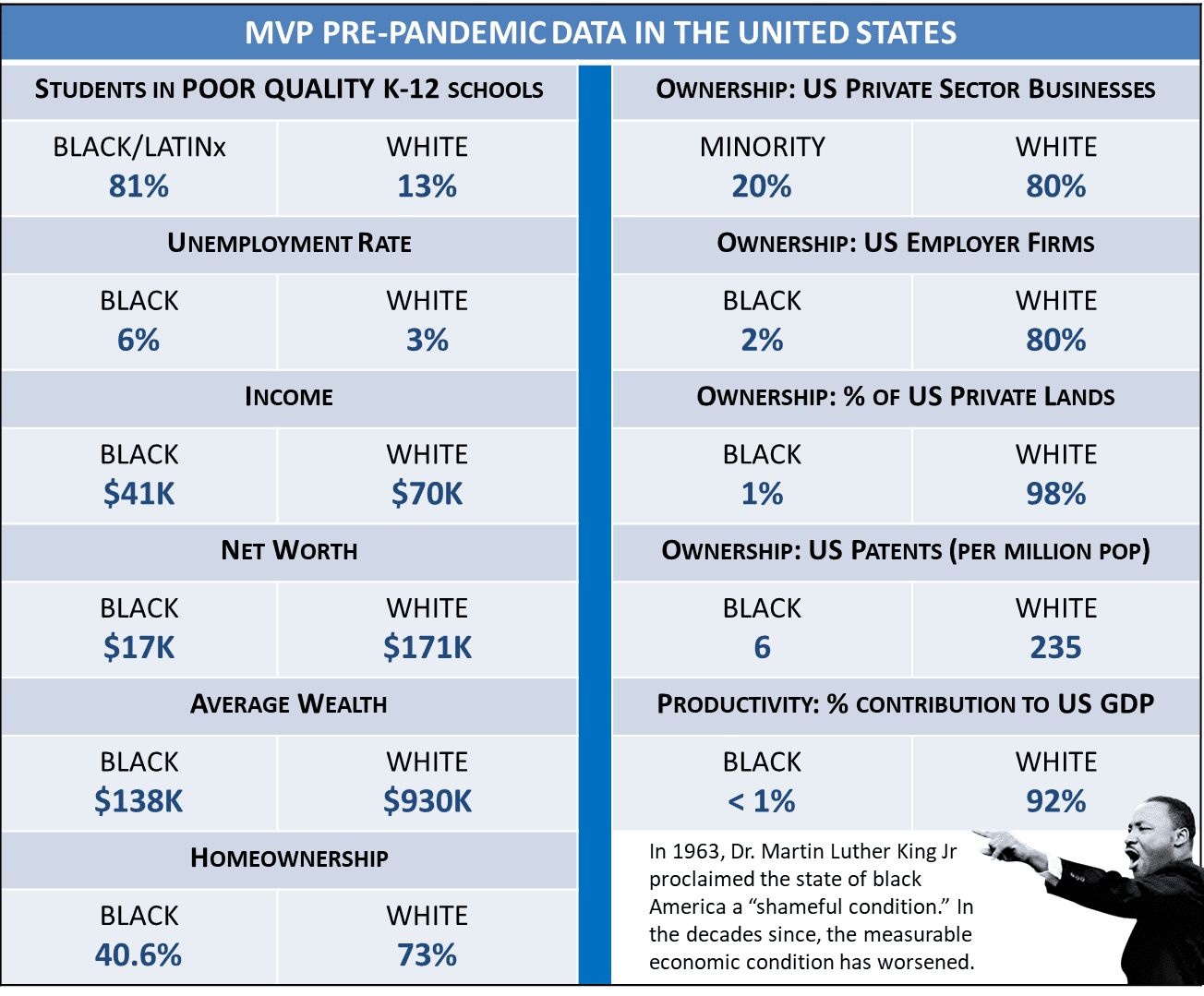Editor’s note: This is part one in a three-part series. Click here for part two, “Establishing Conditions Conducive to Growth of Black Businesses and Entrepreneurship” and here for part three, Prioritizing Racial Equity for Inclusive Prosperity.
A convergence of calamity has caused crisis-level alarm across America. We’re witnessing several historic events unfolding simultaneously:
- A global pandemic last spring caused the entire developed world to temporarily shut down their economies. The U.S. has been unable to gain control of the COVID-19 coronavirus and remains in a state of rising cases and deaths (160,000-plus deaths and rising since March), creating cascading problems for businesses, employees, schools and local economies.
- The killing of George Floyd by Minneapolis police triggered a national outrage that expanded internationally. Sustained protests have elevated cultural awareness spanning a broad spectrum of systemic racial problems we all inherited from a 20th century segregationist society. Rapid racial demographic shifts will soon transform America into a minority-majority multicultural society, and that flip has already occurred in public schools, which fuels fears of encroaching multiculturalism among some segments of society.
- The economic shutdown has exposed myriad systemic problems (health, education, economics, wealth, infrastructure, ownership and access to resources) adversely impacting minority communities disproportionately. White society’s elevated awareness to systemic racial segregation policies and practices and unprecedented response both in the street and in the boardroom is encouraging to see. But I am not so mystified to believe this moment is a movement. It isn’t.
However, there is a small window of opportunity now to transform this moment of national focus into an ongoing movement of permanent transformation toward building a more equitable and inclusive America. We simply need five key items:
- Vision
- Strategy
- Plan of Action
- Investment
- Commitment
Today, there’s no shortage of CEOs and foundation leaders publicly proclaiming promises of support for racial equity activities, diversity and inclusion programs and investments in minority businesses and entrepreneurship. PwC, for example, is leading a group of CEOs for Action. At least 1,000 CEOs have taken a diversity pledge. In Indianapolis, a coalition of key stakeholders led by Eli Lilly and Co., have pledged $2.2 million to advance effective solutions to racial inequality through the Central Indiana Racial Equity Fund. And Indianapolis is also welcoming Black-owned Lightship Capital, a venture capital firm with a $50 million fund and a focus on investing in promising tech-based minority enterprises.
There’s a lot of good activity occurring in spite of an out-of-control pandemic, historic levels of unemployment and a 41% closure rate of Black-owned businesses between March and June (according to data published by the National Bureau of Economic Research).
But let’s be real. Lots of entrepreneurial activity in the past has resulted in chronically low productivity outcomes, particularly for Black and Latinx entrepreneurs.
The moment we’re witnessing today, with an unprecedented amount of attention from the landscape of employers across America, which is 80% white, and the landscape of K-12 education with a teacher landscape that’s 80% white, and a spotlight by a media industry that’s 80% white, requires a vision, strategy and plan that prioritizes increasing measurable productivity among America’s Most Vulnerable Populations (MVP) as a key measure of racial equity success in the next five years.
VISION — STRATEGY
In the midst of a raging pandemic and a historic economic shutdown that has disproportionately hit minority businesses, the National Institute for Inclusive Competitiveness was launched with a vision. The NIIC assembled an experienced team of societal change agents dedicated to the mission of increasing the economic productivity among the nation’s MVP by 1% GDP in one generation. The strategy required to move that needle currently doesn’t exist in any local or regional ecosystem in America, despite more than 50 years of Comprehensive Economic Development Strategies (CEDS) plans produced in every Metropolitan Statistical Area (MSA), funded by federal, state and public-private partnerships.
The success of strategic economic planning processes, such as Accelerate Indy, is indisputable. But heretofore, such economic success across white America over the last 50 years has eluded Black America, which lacks both the necessary economic infrastructure and economic competitiveness strategies to compete in a 21st century globally competitive tech-based innovation economy fueled by a fourth industrial revolution.
For America to sustain her global competitiveness in a post-pandemic era, she must cultivate more talented minority innovators who are prepared, equipped, fully supported and ready to compete in growth stage industries that produce jobs and wealth while contributing meaningfully to local, regional and national competitiveness.
“How Do We Get There From Here,” will be the focus of my discussion at the Beyond 2020 Indiana Minority Business Conference on Aug. 28-29, presented by Innopower LLC and Recorder Media Group. Please join us.
Mike Green is chief strategist at The National Institute for Inclusive Competitiveness and co-founder of ScaleUp Partners, a consultancy specializing in inclusive competitiveness strategies to improve the productivity of underrepresented minorities in the innovation economy. Email mike@niicusa.org.










